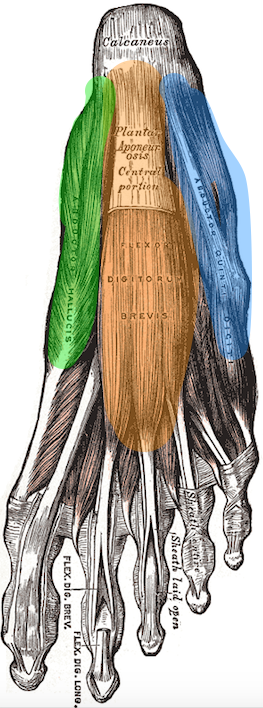Plantar Fasciitis? Probably Not.
Foot pain is one of the more commonly mismanaged areas of the body. A trip to your family doctor, podiatrist or even to the Internet and you will be labeled with plantar fasciitis. Then, you start icing, stretching, taking anti-inflammatories, rolling your foot with a ball, or may have been convinced that getting a cortisone injection was a good idea. You can continue this routine for months or years with minimal results. Your symptoms may reduce or resolve with time, but only because your body compensated putting extra stress on another area of your body to reduce pressure on your foot. This can lead to pain in your other foot, knee, hip, low-back, and/or reoccurring pain in your injured foot over time.
So, where did you go wrong?
It all starts with an inaccurate diagnosis (plantar fasciitis) that can lead to wrong and ineffective treatment methods. It’s crucial to receive a correct diagnosis and receive the right treatment to stay pain free and continue doing everything you love.
To get an accurate diagnosis regarding your foot, it is best to start with a soft tissue specialist. Click here to contact Phipps Soft Tissue and Spine so you can receive the correct diagnosis and treatment and begin your road to recovery.
Below you will find additional information on foot pain, anatomy, and why plantar fasciitis treatments such as injections, stretching, rolling and ice can be a waste of time.
What exactly is plantar fasciitis?
The plantar fascia is a thickened area of connective tissue and is often blamed for pain on the bottom of your foot. The diagnosis of plantar fasciitis implies that the attachment point of the plantar fascia and heel (circled in red below) is inflamed and causing pain.

The plantar fascia, just like all the structures in the foot, is capable of generating pain. However, plantar fasciitis is rarely the main diagnosis as the foot is much more complicated than just the plantar fascia. There are multiple layers of muscles and tendons in your feet that are deep in the plantar fascia. See the pictures below.


In addition, muscles originating in your calf will travel behind your ankle and attach onto your foot as well. The picture below (highlighted in blue, green, and yellow) shows the muscles that originate deep in your calf that travel and attach onto the bottom of your foot (depicted as the red shaded areas)


It is clear that there are many structures in your foot and calf that can contribute to pain. All structures in your foot and calf play a role in stabilizing and keeping your foot pain free. Additionally, they are all capable of developing pathology and generating pain.
The most common pathologies that develop in the foot are:
- Adhesion
- Tendon degeneration
Adhesion
Adhesion can form in any muscle in your foot and calf and form from overuse (standing, walking, running). It acts like glue in your muscles causing them to become weak and less flexible. This will generate pain and cause the tendons in your heel to become overloaded and degenerated (more on this below). A soft tissue specialist will break down adhesion with Manual Adhesion Release™ or Instrument Adhesion Release™. Which treatment they will use will depend on the muscles involved. Below are 2 brief video clips of Dr. Phipps utilizing both techniques on muscles that will contribute to your foot pain.
Treatments such as. injections, rolling your foot on a ball, stretching, ice, and anti-inflammatories will not break down adhesion. With expert treatment, this will improve the function of your foot immediately.
Degenerated Tendons.
A tendon is a soft tissue structure that attaches a muscle to a bone. Below shaded in orange, green, and blue are 3 muscles that have their tendons attach onto the heel. These tendons are capable of degenerating and causing heel pain commonly misdiagnosed as plantar fasciitis.

If you have heel pain that occurs when you take the first few steps out of bed or a chair, this is likely one of your diagnoses. The tendons in your feet can degenerate for months or even years without your knowledge, causing it to one day cross a threshold, resulting in pain that doesn’t go away. This degeneration can occur when the load placed on the tendons is too high and the tendon can’t recover properly, causing it to break down and degenerate. Muscle Adhesion and prolonged standing/walking/running are a few sources that create high loads on your tendons.
Firstly, for treatment of degenerated tendons you should have the adhesion treated to decrease the load on the tendon immediately. Load management advice, orthotics and rehab exercise will depend on your personal case. Then properly managing your case and receiving the correct treatment will allow the tendon to regenerate and become healthy again- meaning your foot will be pain free and stay that way.
Contact Phipps Soft Tissue and Spine today to receive the correct diagnosis for your foot pain. Ignoring your foot pain or relying on ineffective treatment methods will only make your condition worse and harder to resolve.
GET RELIEF NOW
To schedule an appointment, please call us at (716) 629-3100 or take advantage of our convenient online form
*Please note that every patient is different. The content and tips displayed on this page are for educational purposes only, and do not substitute for medical advice. Please consult with a medical or healthcare provider, such as Dr. Phipps, for specific diagnosis and treatment advice. Williamsville, NY 14221 Chiropractor
